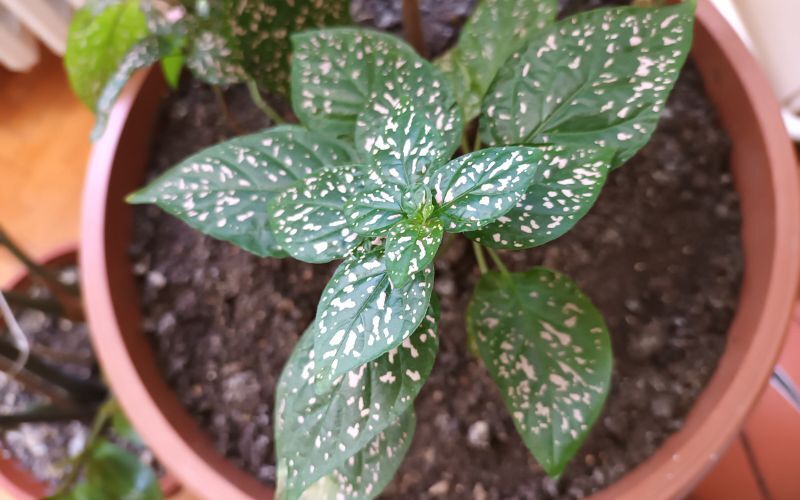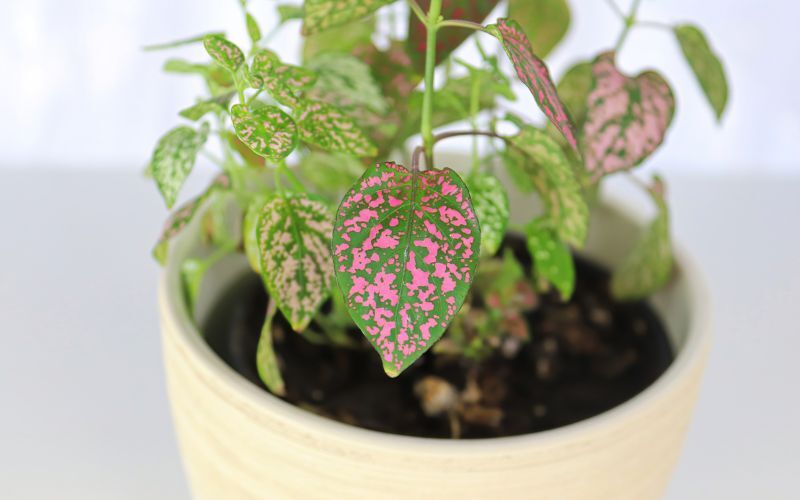Polka Dot plants typically maintain a tidy and mounded growth habit, rarely getting larger than a foot or more in height and width. Repotting is not often needed and one Hypoestes plant will quite happily grow in the same 6-inch pot for years. Plants that seem to be declining in health or infested with pests may need to move into fresh, clean potting soil or a different container with better drainage. The steps involved are simple and can be a great way for new houseplant gardeners to gain experience.

Potting Polka Dot Plant
Step 1 - Gently remove the plant from its nursery pot to keep the root ball intact as much as possible.
Step 2 - if the roots are a solid mass and look like they are circling around the outside of the root system, take a couple of minutes to tease the roots apart to help them grow outward in fresh soil and a bigger pot.
Step 3 - Put a couple of inches of fresh houseplant potting mix in the bottom of the new pot. Do not worry about filling in drainage holes at the bottom. Excess water will flow out easily and will be caught in a drainage saucer or cache pot.
Step 4 - Place the plant in the new pot with the base of the top growth at the same level it was in the old pot. Gently fill in around the root ball with potting mix and firm in with your fingers to remove any large air pockets.
Step 5 - Water the plant well until liquid drains from the bottom. This ensures that the potting mix is saturated.
Repotting Polka Dot Plant
Newly bought plants from the garden center or nursery should always be repotted once roots begin to grow from the bottom drainage holes. Often the plants have been in their grower’s pots long enough to be pot-bound and require a container at least 2 inches larger in diameter to relieve the problem. Once the roots receive more space, they can grow laterally and take up moisture and nutrients more efficiently. Another sign that your plant may be rootbound is stunted leaf growth or yellowing and brown leaves, especially on new growth.

Best Soil For Polka Dot Plant
Tropical houseplants like Polka Dot plants thrive in potting mixes that are well-draining yet also retain moisture between watering sessions. All-purpose mixes made without peat moss are easy to find in garden centers and handy to use for a wide range of plants indoors and outside. Look for a product with perlite, vermiculite or finely shredded bark for a lightweight and well-draining medium.
More experienced gardeners may want to mix up their own potting blends to suit different growing conditions or plants. All of the components for a quality potting mix can be found in garden centers or large nurseries and are easily mixed together and stored in a protected spot. A good mix for houseplants includes one part coconut coir, one part perlite, and one part high-quality compost or worm castings in a 1:1:1 ratio.
Polka Dot Plant Drainage
Drainage for Polka Dot plants is key to keeping them growing happy and healthy for many years. Ensure that the pot has plenty of drainage holes. Place the pot on a drainage saucer to make watering less messy while allowing the potting mix to completely absorb the water.
Plastic pots can be slid into a more decorative outer container. These outer containers are called cache pots and have no drainage. Add a layer of river rocks in the bottom of the cache pot to provide airflow and ensure that the root system does not sit in water.
Sources:
“Pot-bound Indoor Plants”, University of Maryland, www.extension.umd.edu
 Author Robbin Small - Published 27-12-2024 Author Robbin Small - Published 27-12-2024 |
